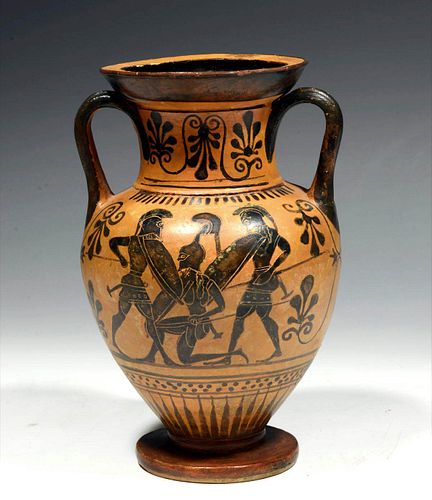Attic Black Figure Amphora, Light-Make Class
Lot 23
About Seller
Artemis Fine Arts
686 S Taylor Ave, Ste 106
Louisville, CO 80027
United States
Selling antiquities, ancient and ethnographic art online since 1993, Artemis Gallery specializes in Classical Antiquities (Egyptian, Greek, Roman, Near Eastern), Asian, Pre-Columbian, African / Tribal / Oceanographic art. Our extensive inventory includes pottery, stone, metal, wood, glass and textil...Read more
Categories
Estimate:
$16,000 - $24,000
Absentee vs Live bid
Two ways to bid:
- Leave a max absentee bid and the platform will bid on your behalf up to your maximum bid during the live auction.
- Bid live during the auction and your bids will be submitted real-time to the auctioneer.
Bid Increments
| Price | Bid Increment |
|---|---|
| $0 | $25 |
| $300 | $50 |
| $1,000 | $100 |
| $2,000 | $250 |
| $5,000 | $500 |
| $10,000 | $1,000 |
| $20,000 | $2,500 |
| $50,000 | $5,000 |
| $100,000 | $10,000 |
| $200,000 | $20,000 |
About Auction
By Artemis Fine Arts
Mar 24, 2022
Set Reminder
2022-03-24 10:00:00
2022-03-24 10:00:00
America/New_York
Bidsquare
Bidsquare : Exceptional Antiquities Ethnographic Fine Art
https://www.bidsquare.com/auctions/artemis-gallery/exceptional-antiquities-ethnographic-fine-art-9057
Museum-worthy examples of classical antiquities (Egyptian, Greek, Roman, Near Eastern), Viking, Far East / Asian, Pre-Columbian, African / Tribal, Oceanic, Native American, Spanish Colonial, Fossils, Ancient Jewelry, Fine / Visual Arts, so much more! Artemis Fine Arts info@artemisgallery.com
Museum-worthy examples of classical antiquities (Egyptian, Greek, Roman, Near Eastern), Viking, Far East / Asian, Pre-Columbian, African / Tribal, Oceanic, Native American, Spanish Colonial, Fossils, Ancient Jewelry, Fine / Visual Arts, so much more! Artemis Fine Arts info@artemisgallery.com
- Lot Description
Greece, Attic, Light-Make Class, ca. 540 to 480 BCE. An exceptional pottery neck amphora, meticulously decorated with hand-painted black-figure technique attributed to the Light-Make Class - a group of Athenian painters whose vases featured black-figure often on white ground. Sitting upon a discoid foot, the opulent vessel displays a bulbous body with a narrow base, a broad, rounded shoulder, a concave neck, and a flared rim. A pair of arched handles gracefully connect neck to shoulder. Skillfully painted, Side A exhibits a lively scene of 3 warriors in battle, all dressed in high-crested helmets and armor as they each hold a shield in 1 hand and a lengthy spear in the other. The central figure sits on 1 knee facing left as the 2 others stand to either side of him, striding toward their fallen foe as they pierce him with their spears. Alternatively, Side B presents the image of a soldier, likely Achilles, flanked by a pair of standing figures or attendants draped in long, bordered himations. Size: 15.2" H (38.6 cm)
Also dressed in armor and a helmet, Achilles strides right while looking left and carries a spear and Boeotian shield with a short sword strapped to his waist. His companions face inward, also holding spears or walking sticks. Scrolling vines of palmettes adorn the field and neck of the amphora with 3 on the neck and 4 between each scene accompanied by a hanging lotus bud that falls below each handle. A horizontal band of ray motif stretches up from the foot, followed by a register of polka dots. The area above the figures is additionally decorated with a ring of vertical striations, while a lustrous black glaze envelops the rim, handles, and foot of the elegant vessel.
Ancient Athenian painters, including the painter of this vessel, took advantage of the large size of Attic vases which gave them more room to explore their techniques, overlap figures, present complex interactions between figures, create depth and attempt renderings of perspective. These techniques are certainly present in the Iliad-inspired scenes that we see here.
Achilles was the son of the nereid or sea nymph Thetis and the mortal Peleus, king of the Myrmidons. Renowned as the mightiest warrior of the army of Agamemnon in the Trojan War, during his childhood, Thetis dipped Achilles in the waters of the River Styx which rendered him invincible, except for the section of his heel by which Thetis held him; hence the term "Achilles' heel."
Cf. Princeton University, Art Museum, y1933-46 and Beazley Archive, 310390.
Provenance: private New York, New York, USA collection; ex-private prominent D.K. collection, New York, USA, acquired in the 2000s
All items legal to buy/sell under U.S. Statute covering cultural patrimony Code 2600, CHAPTER 14, and are guaranteed to be as described or your money back.
A Certificate of Authenticity will accompany all winning bids.
PLEASE NOTE: Due to recent increases of shipments being seized by Australian & German customs (even for items with pre-UNESCO provenance), we will no longer ship most antiquities and ancient Chinese art to Australia & Germany. For categories of items that are acceptable to ship to Australia or Germany, please contact us directly or work with your local customs brokerage firm.
Display stands not described as included/custom in the item description are for photography purposes only and will not be included with the item upon shipping.
#170413Professionally repaired with restoration and re-painting over break lines. Visible chipping to rim. Possible other areas of re-painting. Expected nicks, pitting, and abrasions, throughout, commensurate with age. Otherwise, excellent with impressive preservation of detail.Condition
- Shipping Info
-
All shipping is handled in-house for your convenience. Your invoice from Artemis Gallery will include shipping calculation instructions. If in doubt, please inquire BEFORE bidding for estimated shipping costs for individual items.
-
- Buyer's Premium



 EUR
EUR CAD
CAD AUD
AUD GBP
GBP MXN
MXN HKD
HKD CNY
CNY MYR
MYR SEK
SEK SGD
SGD CHF
CHF THB
THB
















